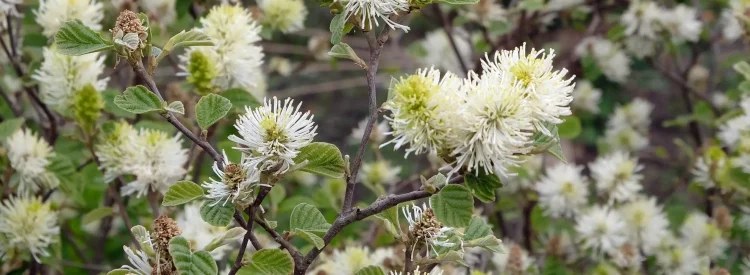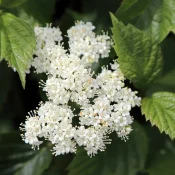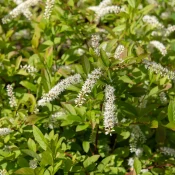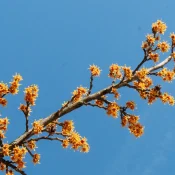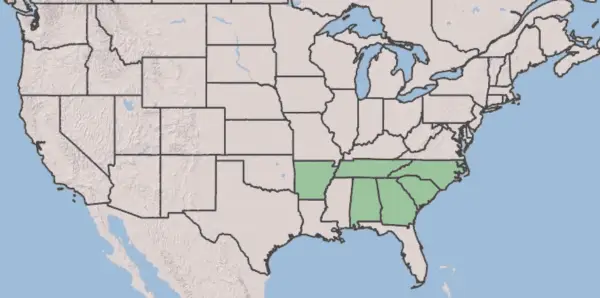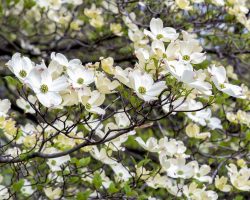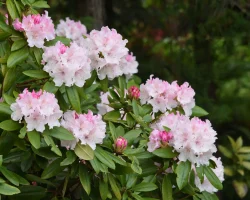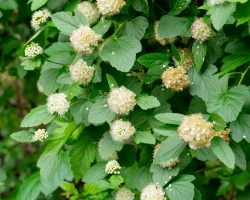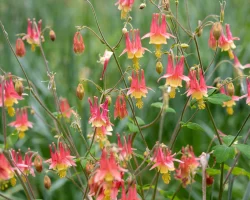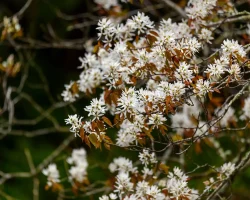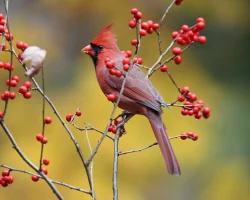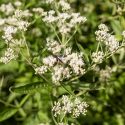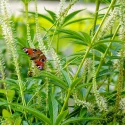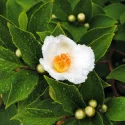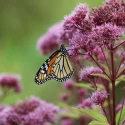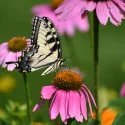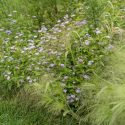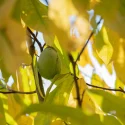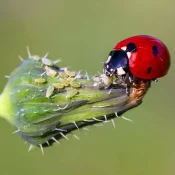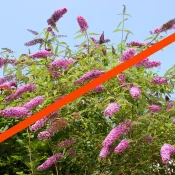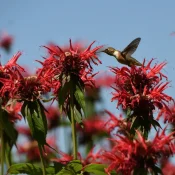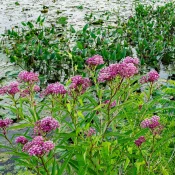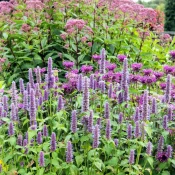Fothergilla is a true four-season stunner, with two native species suited for different conditions—one for well-drained areas and another for wetter sites. In spring, both burst into bloom with fragrant, bottlebrush-like flowers, followed by lush green foliage in summer. Come fall, they put on a spectacular show, turning brilliant shades of yellow, orange, and red. Long-lived and easy to care for, Fothergillas are a powerhouse shrub for any garden. Scroll on for planting tips.
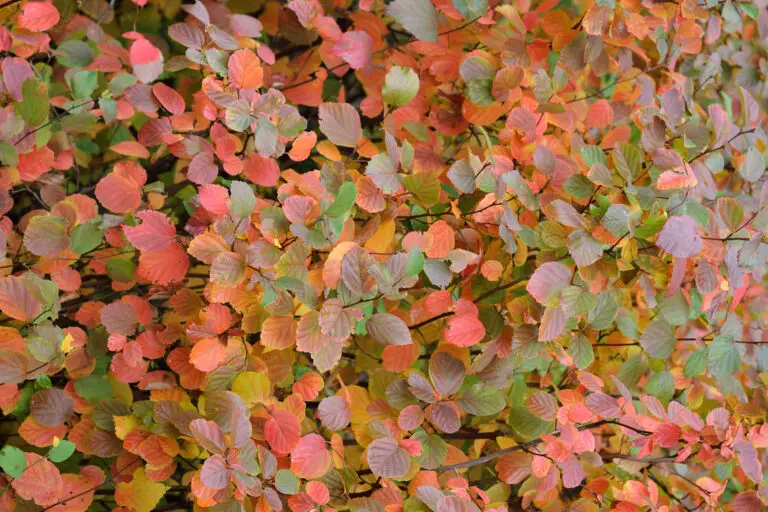
Fothergilla is an all-season beauty that deserves a spot in more gardens. It’s native to the southeastern U.S. and brings something to admire in every season—fragrant spring flowers, lush summer foliage, dazzling fall color, and a tidy structure in winter. In this article, we’ll share planting tips, naming backstory, and some sourcing ideas.
First, let’s introduce both fothergillas.
Two species of fothergilla, each with their benefits
There are two fothergilla species native native to North America. They look very similar, but like different environments and have different sizes:
- Dwarf Fothergilla (Fothergilla gardenii) maxes out at 3-4 feet and thrives in wetter areas.
- Large Fothergilla (Fothergilla major) is better suited for well-drained soils and gets taller over time, reaching up to 8-10 feet.
Both are excellent choices for front yards, borders, and pollinator gardens. A handful of cultivars are also available (more on that later).
Now that we’ve introduced both, you might be wondering…
How do I say fothergilla?
You pronounce it like you’re saying “father” + gill + ending on a strong A. Like this:
Father-gill-ah
Now you’re probably asking—
Who or what is a fothergilla?
Fothergilla is named after John Fothergill, an 18th-century British physician, botanist, and forward thinker. Among his many ahead-of-his-time ideas? Advocating for smallpox inoculation—because apparently, some debates never die, even 300 years later.
Though Fothergill never set foot in North America, his influence traveled far. He supported early Philadelphia hospitals with medical books and funded plant-hunting expeditions, including those of John and William Bartram—who, thanks to his sponsorship, discovered the now-extinct-in-the-wild franklin tree.
Feeling a little bleh knowing this stunning North American native is named after a long-dead European?
We hear you.
This is one of many native plants with European backstories. Black-Eyed Susans and magnolias share similar naming disappointment. Ready to hear a Hollywood-worthy plant story about a Native American hero? Read our profile of Joe Pye weed. Or laugh at some bad copywriters in our article Terrible Names, Beautiful Native Plants.
Let’s move on from the strange name and get to the plants.
What are the benefits of growing fothergilla?
- Spring blooms: White, honey-scented, bottlebrush flowers appear before the leaves emerge, making them one of the first nectar sources for pollinators.
- Long-time flowers: flowers last for 2 to 3 weeks in the spring.
- Fall color: The foliage turns brilliant yellow, orange, and red in autumn, rivaling even the showiest of maples.
- Low-maintenance: Once established, fothergilla requires little upkeep.
- Wildlife-friendly: Provides nectar for early-season bees and a dense shrub layer for birds.
- Long-lasting: Happy fothergillas can live for 40+ years. Spend a morning or afternoon planting and enjoy for decades.
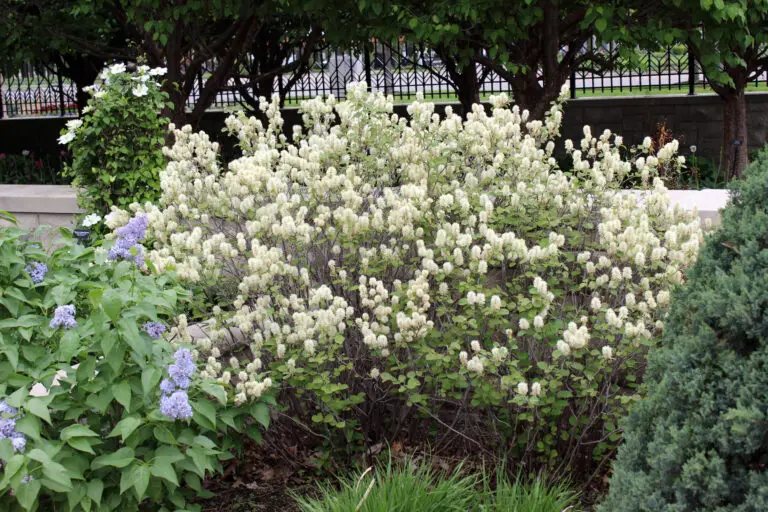
Does it remind you of another plant? There are a few native flowers in the same genus or that have similar flower shapes. Here are some similar natives:
Native shrubs similar to fothergilla
There are a few other natives that look and behave similarly to fothergilla, with different coloring and heights:
In fact, since we brought up witch-hazels, it’s worth mentioning that sometimes fothergillas go by the name Mountain Witchalder or Witchalder.
How to grow fothergilla
There are a few things to note as you consider planting either species of fothergilla in your yard:
- Sun: A large range of sun makes this easy for beginner gardeners—happy with part to full sun.
- Soil: Both species prefer acidic soil but will tolerate a range of conditions.
- Watering: Water regularly during the first year to establish strong roots. Once established, large fothergilla is drought-tolerant, while dwarf fothergilla prefers consistent moisture.
- Spacing: Give them room to grow—dwarf fothergilla stays around 2–3 feet tall and wide, while large fothergilla can reach up to 8–10 feet tall over time.
- Pruning: Rarely needed! If shaping is desired, prune lightly after flowering.
One note about fothergilla: they are slow-growing, just a few inches a year. This can be great news if you’re planting in a spot where you want the shrub to stay small, like against a house foundation or front garden.
Where is fothergilla native?
It depends on the species! Here are the native ranges for both types.
Dwarf Fothergilla
Fothergilla gardenii
Dwarf fothergillas’ native range is just four states. Due to climate change, these natives are now happily grown in climates as north as Massachusetts.
Large Fothergilla
Fothergilla major
The native range of large fothergilla is also limited to just four states, and again—due to climate change—northern regions can now grow this plant.
What if you don’t live in these states?
Live in the Midwest, Northeast or Mid-Atlantic and want to plant a fothergilla? Plant one!
Lots of trusted native plant resources recommend this plant, even when out of its natural native range. The Native Plant Trust (based out of Massachusetts) says, “Though not native to New England, Fothergilla gardenii [Dwarf Fothergilla] has been an important part of many native gardens for many years, and with good reason.” The popular Dwarf Fothergilla cultivar, “Mount Airy,” is named for the place where it was found: Mt. Airy Arboretum in Cincinnati, Ohio—although it’s not native there, either.
Planting natives outside of range is always better than planting far-flung exotic species.
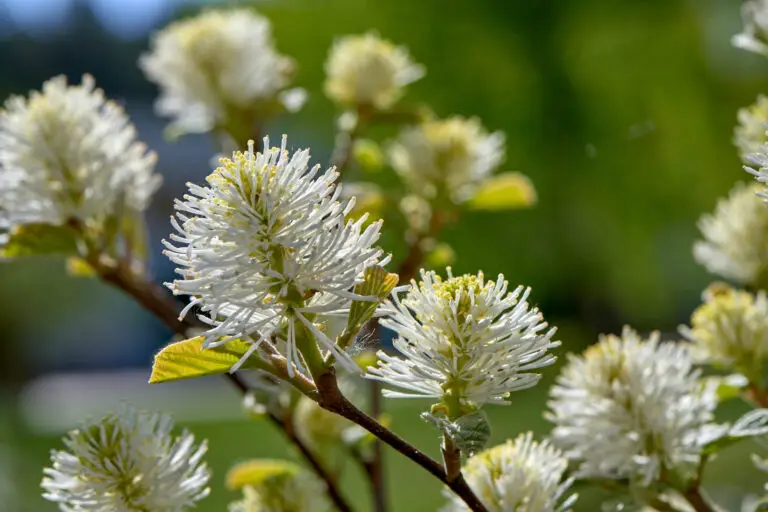
Where should I plant fothergillas?
Sometimes, landscaping advice can be a single sentence. Susan Mahr at the University of Wisconsin-Madison says it nicely,
“Place where the fragrance can be appreciated or against a dark-colored wall or in front of evergreens where the darker backdrop will set off the flowers and fall color.”
Amen, Susan. (We did this in our Philadelphia garden it’s sublime to walk out with a cup of coffee in the spring, smelling the fothergilla blossoms while the pollinators tumble around.) NC State University and Longwood Gardens have a helpful 2-minute video overview of Dwarf Fothergilla:
Where can I find fothergillas?
We will not lie and say that finding fothergilla will be as simple as driving to your closest big box nursery. It might take a little extra energy to find this native gem, but it is worth it! Here are some recommendations for sourcing this native plant:
Where can I find seeds and plants?
Finding native plants can be challenging (we partly blame Marie Antoinette.) To make it easier, we’ve assembled four sourcing ideas.
300+ native nurseries makes finding one a breeze
Explore 100+ native-friendly eCommerce sites
Every state and province has a native plant society; find yours
Online Communities
Local Facebook groups are a great plant source
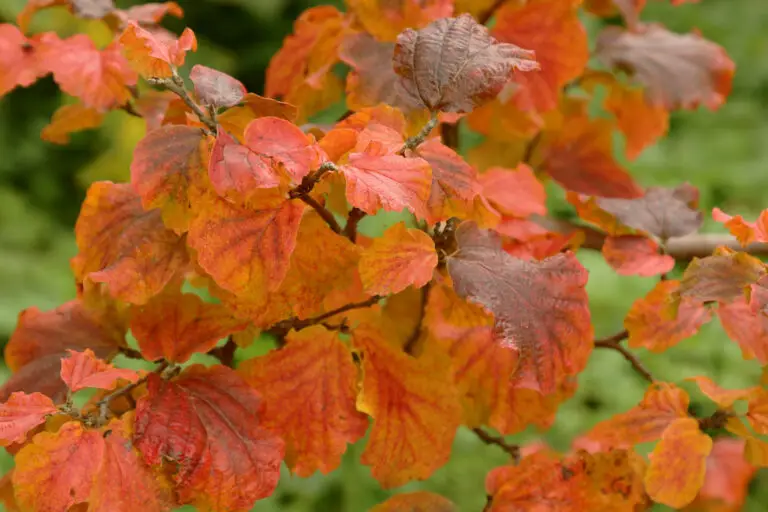
What are good pairings for fothergillas?
Good native pairings for fothergillas can depend on which species you’re planting (Dwarf likes wetter soils, Large likes well-drained.) But! There are a few native species that thrive in a large variety of situations. Some ideas for pairings include:
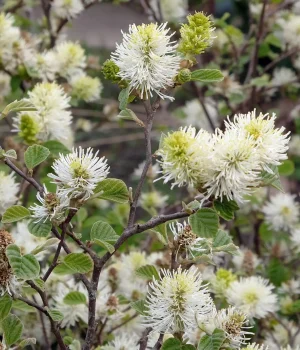
Pairs well with
If you want a shrub that works hard for your landscape—feeding pollinators, brightening up fall, and needing almost no maintenance—fothergillas are an excellent choice. Whether you need a compact shrub for a damp spot or a larger, drought-tolerant accent, these native gems deliver. Find the right species for your space, plant it once, and enjoy the show for years to come.
Looking to explore some other strangely named plants? Head over to our Terrible Names, Beautiful Natives, or our profile on Joe Pye Weed. Happy planting!
Sources
- Balogh, Anne. GardenDesign.com. “Fothergilla – How to Grow & Care for This Fabulous Shrub,” Garden Design, n.d.
- Wisconsin Horticulture. “Fothergilla,” 2025.
- Oregonstate.edu. “Fothergilla Major,” Landscape Plants | Oregon State University, n.d.
- Ncsu.edu. “Fothergilla ‘Mount Airy’ (Dwarf Fothergilla, Mt. Airy Fothergilla),” North Carolina Extension Gardener Plant Toolbox, n.d.
- Ncsu.edu. “Fothergilla Gardenii (Coastal Witch-Alder, Dwarf Fothergilla),” North Carolina Extension Gardener Plant Toolbox, n.d.
- Quakersintheworld.org. “John Fothergill,” n.d.
- Usda.gov. “Fothergilla Gardenii,” USDA Plants Database,” n.d.
- Usda.gov. “Fothergilla major,” USDA Plants Database,” n.d.
- Native Plant Trust. “Fothergilla Gardenii.” New England Wild Flower Society, n.d.
- Quaker Strongrooms. “Dr John Fothergill,” November 8, 2019.
- Quakersintheworld.org. “Botanists in America,” n.d..
- Upenn.edu. “Pennsylvania Hospital History: Historical Timeline – Dr. John Fothergill,” University of Pennsylvania Medicine, 2017.
- Oregonstate.edu. “Fothergilla Major,” Oregon State University,” n.d.
- Psu.edu. “Fothergilla—a Four Season Shrub to Consider for Your Garden,” Penn State Extension, 2024.
What if your feed was actually good for your mental health?
Give your algorithm a breath of fresh air and follow us.
